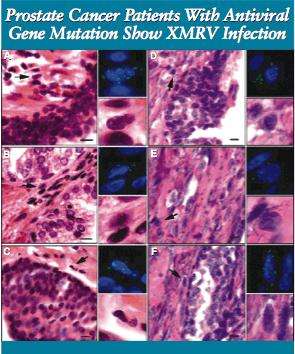XMRV Retrovirus Found in Some Prostate Ca's
A previously unknown virus, a xenotropic murine-like retrovirus or XMRV, has been shown to be 30 times more common in men with prostate cancer who are homozygous for a defect in the HPC1 gene than in men without the mutation
SAN FRANCISCOA previously unknown virus, a xenotropic murine-like retrovirus or XMRV, has been shown to be 30 times more common in men with prostate cancer who are homozygous for a defect in the HPC1 gene than in men without the mutation (see Figure above). Eric A. Klein, MD, professor of surgery, Cleveland Clinic Lerner College of Medicine, reported the study findings during a general session and media briefing at the 2006 Multidisciplinary Prostate Cancer Symposium (abstract 304).
"This is a very exciting finding," said Dr. Klein, lead author of the study and head of urologic oncology at the Glickman Urologic Institute of the Cleveland Clinic Foundation. "But while we were pleased, we were not totally surprised. Much data suggest that prostate cancer may be an infectious disease, but the issue was waiting for the technology to catch up." The technology that allowed researchers to "catch up" is a DNA ViroChip, developed by researchers at the University of California, San Francisco. The DNA ViroChip contains genetic sequences derived from all known viruses (about 950 viruses). Using this new technology in 19 prostate cancer samples, Dr. Klein and his colleagues were able to detect the presence of a probable retrovirus in half of samples that were homozygous (QQ) for an HPC1 mutation known as R462Q, but in only one non-QQ sample. Further work led to the cloning and sequencing of XMRV (Xenotropic MuLV-related virus).
Next, the researchers used a specific RT-PCR assay to examine tissue samples from 86 men with prostate cancer who had undergone radical prostatectomy at the Cleveland Clinic. Out of the 20 samples from men who were homozygous (QQ) for R462Q, nine (45%) contained XMRV. Only one (1.9%) of the 52 samples from men who were homozygous for the normal gene contained the virus. XMRV was not found in any of the 14 heterozygous samples.
Role of RNase L Protein
Dr. Klein explained how variants of the antiviral protein ribonuclease L (RNase L) may increase susceptibility to prostate cancer. When functioning properly, the protein prevents infection by triggering a mitochondrial pathway of apoptosis that eliminates virus-infected cells. Dysfunction of the protein may occur when HPC1 (Hereditary Prostate Cancer 1), a gene mapped to the RNASEL gene, has a genetic alteration, particularly the R462Q variant. Men with the variant may be more susceptible to infection with the XMRV virus or may have decreased ability to fight the virus once it is acquired.
"The hypothesis is that infection leads to chronic inflammation of the prostate, which ultimately leads to cancer," Dr. Klein said. The RNASEL gene was cloned 15 years ago by Robert H. Silverman, PhD, professor of cancer biology at the Cleveland Clinic and a collaborator of the new research.
As its name implies, XMRV is closely related to xenotropic murine leukemia viruses. The new virus exhibits 94% nucleotide homology with murine leukemia virus MuLV DG-75, Dr. Klein said. He hypothesized that the virus "jumped from mouse to man many millennia ago."

PAGE 1 A new retrovirus XMRV was detected in prostate tissue from these two prostate cancer cases (A-C & D-F) homozygous for an RNASEL mutation: FISH+ cells in green (top right enlargements); arrows in left panels (H&E stain) show FISH+ cells (bottom right enlargements).
Dr. Klein noted that analysis of prostate tissues from XMRV-positive cases detected the virus only in stromal cells, predominantly fibroblasts adjacent to the tumor. He suggested that viral infection of stromal cells may somehow influence tumor growth. The infection could lead to the production of cytokines or growth factors that signal cell proliferation, he said, or could change the tumor microenvironment to promote angiogenesis or oxidative stress.
Causal Relation Not Proven
Dr. Klein cautioned that "we have not proven that this virus causes prostate cancer. We'll spend the next few years finding out if there is a causal relationship." He speculated that the virus could be sexually transmitted. The researchers are planning an epidemiological study to look at the association between sexual history, personal and family medical history, viral infection, and prostate cancer.
The research was published online on March 31, 2006, in PLoS Pathogens: (Urisman A, Molinaro RJ, Fischer N, et al: Identification of a novel gammaretrovirus in prostate tumors of patients homozygous for R462Q RNASEL variant. PLoS Pathog (2[3]:e25). The DOI is 10.1371/journal.ppat.0020025.
Prolaris in Practice: Guiding ADT Benefits, Clinical Application, and Expert Insights From ACRO 2025
April 15th 2025Steven E. Finkelstein, MD, DABR, FACRO discuses how Prolaris distinguishes itself from other genomic biomarker platforms by providing uniquely actionable clinical information that quantifies the absolute benefit of androgen deprivation therapy when added to radiation therapy, offering clinicians a more precise tool for personalizing prostate cancer treatment strategies.